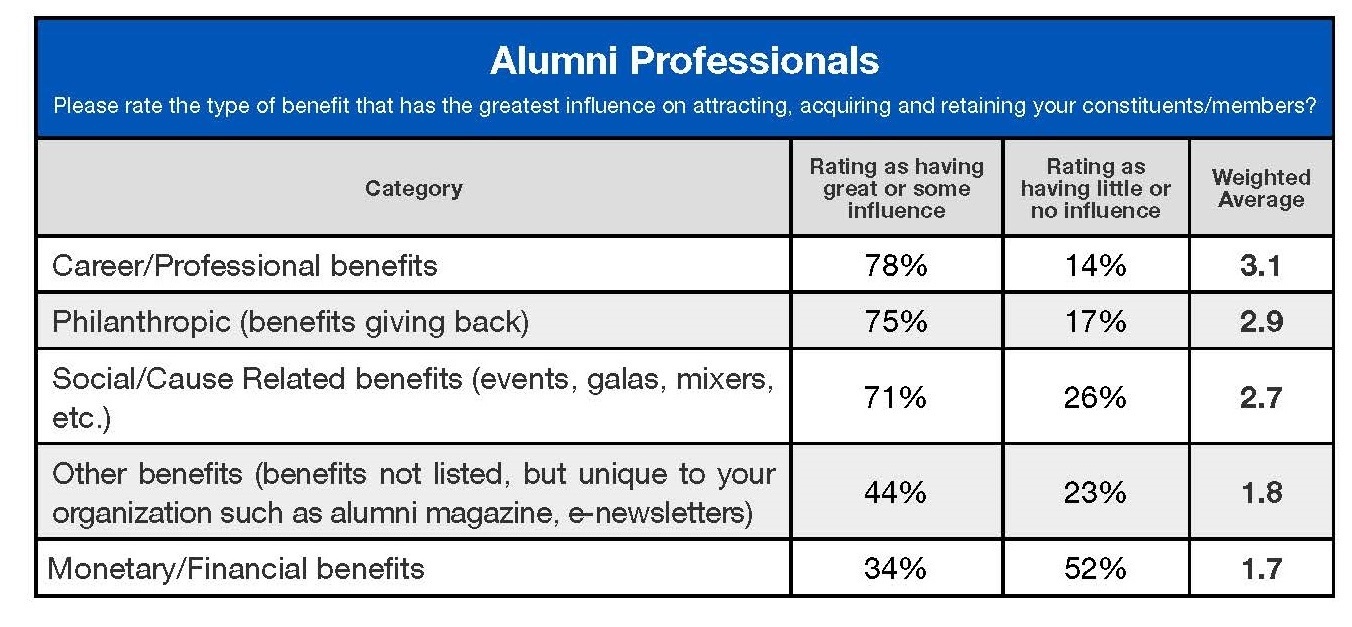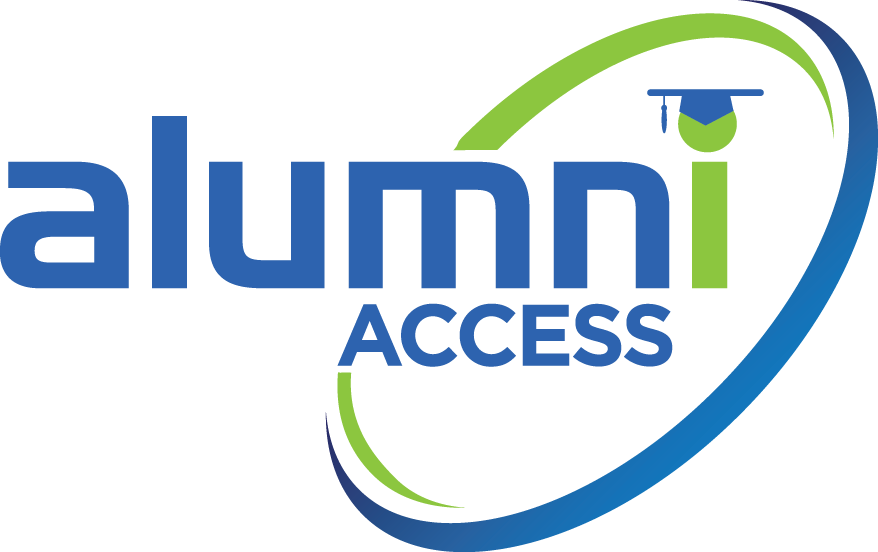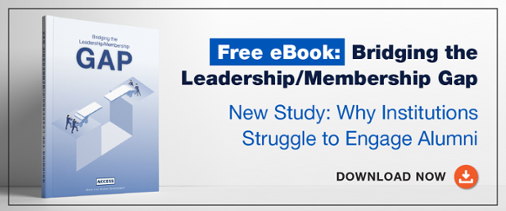SUMMARY: Higher education alumni organizations rely too much on alumni altruism, and fail to give alumni many benefits with real value. A new ebook reveals the data, and offers new solutions to help leaders boost alumni engagement. About a 5 minute read.
Institutions of higher education have a long history of appealing to their alumni's sense of altruism and philanthropy to generate donations. But a new study compares alumni organizations with all types of constituent-based organizations, and the results show that too many appeals to alumni altruism can backfire, leading to less engagement and giving.
The new study compares alumni/advancement professionals with leaders from nearly all other types of member-based organizations, like trade associations, unions, and non-profit groups. What do these organizations have in common with alumni organizations?
Quite a bit if you consider what they do. (BTW - I’m using the term “member” generically. I’m considering all types of constituents, whether they pay dues, fees or are otherwise simply affiliated with an organization.)
For all professionals responsible for driving member engagement, the priorities and goals are much the same. First, you attract the attention of members and get them to engage with the organization. Engagement can mean different things to different groups, but for most, it involves getting a constituent to invest their time, talent, or treasure with the organization. Once they become engaged, you work hard to retain these engaged members over time.
Attract. Engage. Retain. Three pretty straightforward concepts in this industry. Right?
But results from this new nationwide study found some very interesting differences in how Alumni/Advancement professionals approach these tasks, as opposed to all other member-based organizations.
To illustrate these differences, let’s briefly show some relevant data points from the study.
First, how do alumni professionals rate themselves for how well they understand the needs of their alumni?
I won’t go into the details, but it shows a 52% gap between leaders from non-alumni organizations and how alumni leaders rate their understanding of their members. It's the biggest gap among all types of organizations.

Second, we asked how alumni professionals assess the value of the benefits they offer, and compared the answer with non-alumni professionals. We found a 56% gap between alumni and non-alumni professionals. In every category, alumni professionals rate their benefits as having lesser quality than other organizations.

I list these two findings for a little background into the differences in how most organizations use benefits to attract and engage their members, but the data further reveals some additional differences that are worth noting.
The data shows how member professionals differ in their priorities. Starting with NON-Alumni professionals, here are their top priorities:

For trade associations, unions, and other non-alumni professionals, their value proposition is their highest priority. Their most critical priorities relate to advocacy on behalf of their members, and delivering first-rate member services.
Now let’s look at how alumni/advancement professionals prioritize their time:

The study suggests their highest priority is on board relations and fundraising. Not much is related to improving the organization’s overall value proposition. In fact, planning events and building their “organizational brand” has a higher priority than enhancing their benefits.
Why is there such a big difference?
This next graph will help shed further light on the reasons why alumni organizations are falling behind other types of member organizations.
But first, I need to briefly offer some clarifying definitions.
In conducting our survey, we knew that comparing all types of member benefits among so many different types of membership groups would be next to impossible. Finding a way to arrive at an "apples-to-apples" comparison required us to organize member benefits into five basic categories:
- Career/Professional benefits: (includes networking, certification, training/continuing education, trade shows, career services, etc.)
- Social/Cause Related benefits: (includes cause advocacy, events, galas, mixers, access to influential people, etc.)
- Philanthropic/Altruistic benefits: (such as the appeal of giving back, fulfilling a sense of altruism or connection to something important, making a difference, helping the community, etc.)
- Monetary/Economic benefits: (Member’s only retail and restaurant discounts etc., as well as insurance other financial products, etc.)
- Other benefits: (benefits unique to the organization)
With that understanding, let’s compare the types of benefits that have the greatest influence on attracting and engaging members, starting with NON-alumni professionals. Here’s how they rate their most influential member benefits:

Next we see how alumni professionals rate their most influential member benefits:

All professionals rate career services as their most compelling benefit. No surprise there. This is consistent across the board, with the vast majority of respondents, for all types of organizations we surveyed.
However, alumni professionals rate the second most influential benefit as a Philanthropic benefit, the “benefit of giving back,” of “paying back what the institution gave you.”
"Among all types of constituent-based organizations, including charitable groups, trade associations and humanitarian organizations, etc, our research suggests that no other type of organization relies more heavily on altruistic/philanthropic generosity than do higher education alumni organizations."
This conclusion is not only based upon the findings of this study alone. Our VAESE Alumni Relations Benchmarking survey asked alumni professionals to consider their overall suite of benefits and rate the influence of all their benefits on motivating alumni to join, give or engage. We saw 45% of institutions report they do not offer any benefits, but rely instead on the “philanthropic generosity” of their alumni. (See Question 26, pp44 of VAESE Alumni Relations Benchmarking study).
When we consider how all other member-based organizations engage their members with benefits, they rate altruism or the “philanthropic benefit” as the lowest for its influence on attracting and engaging their constituents.
Why Alumni Organizations Struggle to Engage
When we consider how all other member-based organizations engage their members with benefits, appealing to altruism or the “philanthropic benefit” is rated the lowest overall for their influence on attracting and engaging their constituents.
“Of all the potential reasons for the long-term slump in alumni giving and engagement, a primary reason relates to this misplaced reliance on the altruistic motivations of their alumni. Alumni are tired of being asked to give, and then getting little of value in return.”
Alumni receive value from other types of organizations they associate with, whether it’s a frequent flyer club, their Amazon membership, or a points-based credit card. Alumni also want a give-and-take relationship with their alma mater, but they're not getting it.
Our research suggests that institutions should stop ignoring their value proposition and start offering more compelling benefits. Relying on your alumni’s sense of philanthropy and altruism may get a gift in the door, but it will not improve alumni engagement. Over time, it's likely to weaken it.
When looking at all types of successful organizations, those who focus on offering valuable benefits have the greatest levels of engagement. This is further confirmed by looking at the alumni associations of the Power 5 conference schools. Fully 95% of these institutions offer a suite of meaningful benefits.
Philanthropy will always have a place in higher education alumni relations... but let’s get over this notion that abusing your alumni’s sense of altruism is free of long-term consequences.
All meaningful relationships are about give and take, and today's alumni are looking for a reciprocal relationship.
To view the study referenced in this article, go here: click here


